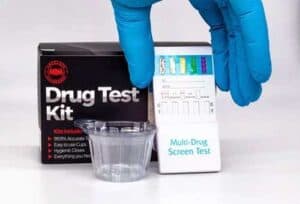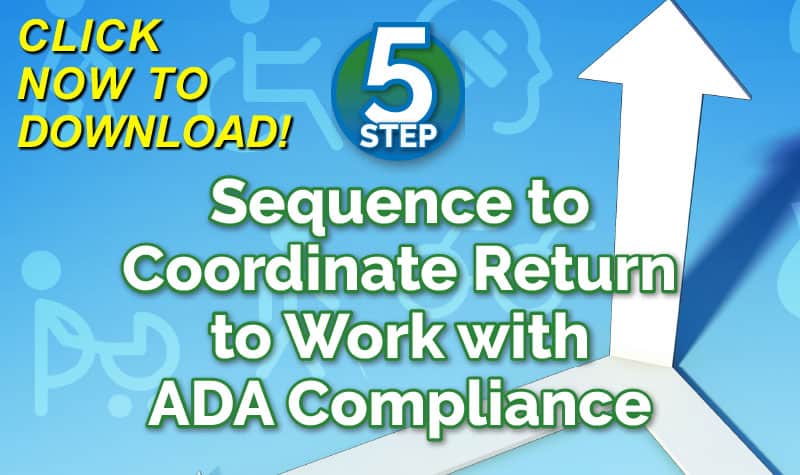
A drug test involves taking a biological specimen and having it analyzed for the presence or absence of specific drugs or their metabolites (the products of metabolism). The biological specimen can be urine, blood, hair, saliva or even sweat.
The most common drug test is the urine drug screen. This typically involves collecting a urine specimen in a cup specifically designed for this purpose. The cup comes with a cap that seals and the cap is taped down with tamper resistant tape. A label with the either the employee’s name or a unique number assigned to the employee is used to identify from whom the specimen was obtained. The urine specimen is delivered to the laboratory where it is screened for drugs.
Click Link to Access Free PDF Download
“5-Step Sequence to Coordinate Return-to-Work with ADA Compliance”
At the laboratory, the most common drug screen is the one required by the federal government for commercial class drivers licenses. It is referred to as the SAMHSA 5 panel. (SAMHSA – Substance Abuse and Mental Health Services Administration). The five substances tested for are:
- Cannabinoides (marijuana, hash)
- Cocaine (cocaine, crack, benzoylecognine)
- Amphetamines (amphetamines, methamphetamines, speed)
- Opiates (heroin, opium, codeine, morphine)
- Phencyclidine (PCP)
To perform the testing, the specimen is split into half. The first half goes into an analyzer that measures the presence or concentration of a substance in the urine. If the test shows the presence of a drug, the second half of the urine is test using a gas chromatography method (which means they separate the urine into the various substances within it). The test results are then reviewed by a physician for confirmation of the results. If the test results are negative, the employer is advised the drug test was negative. If the test results are positive, the employee is contacted to see if there is any valid reason for the test result to be positive – for instance a prescription drug.
A drug test that is more accurate than the testing of urine is a blood test. The blood sample is drawn from the employee, labeled and sent to the laboratory where it is placed in centrifuge where the blood plasma and blood cells are separated. The plasma is then tested for the presence of illicit drugs. Blood testing is not commonly used as the collection method is considered more intrusive and it is most expensive method of drug testing. However, it is considered the most accurate drug test.
In the last decade the use of hair in laboratory test for the detection of illicit drugs has developed into a reliable forensic toxicology method that has been approved by the courts. Once ingested, cannainoids, cocaine, amphetamines and opiates are metabolized by the body. Their breakdown products enter the hair root where they are deposited and remain until the hair grows out and is cut off or the hair falls out. Except for the abuse of alcohol, hair is considered a very reliable indicator of illicit drug use up to 90 days after the drug was ingested.
As most illicit drug users know the urine test and blood test are accurate for only recent use of the illicit drugs, they will often try to delay their drug testing until their body has had an opportunity to eliminate the drugs. Time is not the only factor that determines whether or not the drug test will reflect recent use of an illicit drug. Factors that impact the drug testing include the type of drug used, the body mass, the metabolic rate, the age of the user, the overall health of the user, the amount and frequency of use, and with urine drug test – the urine pH.
A urine drug test has a longer detection window of time then a blood test. Urine test are accurate for cannabis for a minimum of 3 days and up to 7 days, but up to 30 days for heavy users or users with high body fat. Urine test are accurate for cocaine for a minimum of 2 days and up to 5 days. Urine test are accurate for amphetamines for a minimum of 1 day and up to 5 days (except for methamphetamine, it is accurate for 3 to 15 days). Urine tests are accurate for codeine for 2 to 3 days, heroin 3 to 4 days and for PCP for 3 to 7 days for a single use, but up to 30 days for chronic users of PCP.
According to the Tennessee Department of Labor, thirty-eight to fifty percent of all workers compensation claims are related to substance abuse. How the illicit use of drugs will impact the work comp claim varies tremendously from state to state. In approximately 40 states the employee’s workers compensation benefits can be denied or reduced for being under the influence of drugs at the time of accident.
Author Rebecca Shafer, JD, President of Amaxx Risks Solutions, Inc. is a national expert in the field of workers compensation. She is a writer, speaker and website publisher. Her expertise is working with employers to reduce workers compensation costs, and her clients include airlines, healthcare, printing/publishing, pharmaceuticals, retail, hospitality and manufacturing.
Do not use this information without independent verification. All state laws vary. You should consult with your insurance broker or agent about workers comp issues.
©2011 Amaxx Risk Solutions, Inc. All rights reserved under International Copyright Law. If you would like permission to reprint this material, contact us.




Do they also test to see if ur using fake pee
This is some interesting info about drug testing. I actually didn’t know that the test was split in half, the second half only being used if the first is tested positively. I agree with this though, so that just in case their was a mistake, it’s fair for everyone.